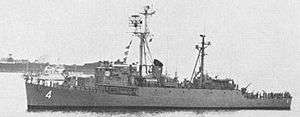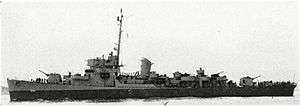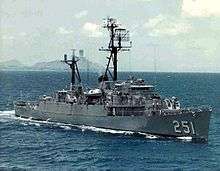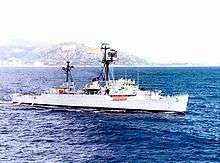BRP Rajah Lakandula (PF-4)
 BRP Rajah Lakandula (PF-4) | |
| History | |
|---|---|
| Name: | Camp |
| Builder: | Brown Shipbuilding Co., Houston, Texas |
| Laid down: | 27 January 1943 |
| Launched: | 16 April 1943 |
| Commissioned: | 16 September 1943 |
| Recommissioned: | 31 July 1956 |
| Renamed: | USS Camp (DER-251) |
| Reclassified: | Radar Picket |
| Struck: | 30 December 1975 |
| Motto: | If by sea |
| Fate: | Transferred to Republic of Vietnam Navy on 13 February 1971.[1] |
| Badge: |
 |
| Name: | Tran Hung Dao |
| Operator: | Republic of Vietnam Navy |
| Acquired: | 13 February 1971 |
| Decommissioned: | 1975 |
| Fate: | Escaped to the Philippines in 1975 after the fall of South Vietnam. |
| Name: | Rajah Lakandula |
| Namesake: | Lakandula was the native ruler of the pre-colonial Kingdom of Tondo when the Spanish colonizers first came to the island of Luzon. |
| Operator: | Philippine Navy |
| Acquired: | 5 April 1976[1][2] |
| Commissioned: | 27 July 1976 |
| Decommissioned: | 1988[1][2] |
| Struck: | 1988[1][2] |
| Fate: | Decommissioned from the Philippine Navy in 1988, used as a stationary barracks ship as until 1999. Probably sold as scrap. |
| General characteristics | |
| Class and type: | Rajah Lakandula class |
| Type: | Destroyer Escort / Frigate |
| Displacement: | 1,200 tons standard, 1,590 tons full load |
| Length: | 306 ft (93 m) |
| Beam: | 36.83 ft (11.23 m) |
| Draft: | 12.25 ft (3.73 m) |
| Installed power: | 6,000 hp (4,500 kW) |
| Propulsion: |
|
| Speed: | 21 knots (39 km/h; 24 mph) (maximum) |
| Range: | 9,100 nmi (16,900 km; 10,500 mi) at 12 knots (22 km/h; 14 mph) |
| Armament: |
|
The BRP Rajah Lakandula (PF-4) was a Destroyer Escort / Frigate of the Philippine Navy, and was its only ex-USN Edsall-class destroyer escort. She was also the flagship of the Philippine Navy from 1981 to 1988.
History

Commissioned in the US Navy as the USS Camp (DE-251) in 1943, and assigned as escort for s convoy bound for Casablanca with men and supplies for the operations in Italy. She was also assigned to convoy escort operations from New York to ports of the United Kingdom, guarding convoys whose ships brought troops and mountains of equipment and supplies for the buildup and support of the assault on the European continent. Fighting the foul weather common in the North Atlantic, Camp's alertness against submarine attack and diligence were rewarded by no losses in any of the convoys she accompanied. A collision with a merchantman, in which one of her crew members was killed, required a repair period during which Camp received a new bow and acquired 5" guns; otherwise her escort duty was uninterrupted until 19 June 1945. Camp was then assigned in the Pacific, and after serving as a training ship at Pearl Harbor, proceeded to Eniwetok for occupation duty. She supervised the evacuation of the Japanese garrison from Mili, then took on air-sea rescue duties off Kwajalein until 4 November, when she sailed for home, arriving at New York 10 December 1945.

She was decommissioned 1 May 1946 and her U.S. Coast Guard crew was removed. She was reclassified DER-251 on 7 December 1965, Camp was recommissioned 31 July 1956 for duty as radar picket ship in the early warning system. She reported to [Newport, Rhode Island] as part of ComCorTron 16, 19 February 1957 and operated from that port to Argentia, Newfoundland, and into the North Atlantic through 1962. In 1963 she served off of Cuba as a Radar Picket Ship tracking Russian Convoys and rescuing Cuban refugees that had fled the island.
In 1965, "Camp" was sent to Indo-China for coastal patrol and interdiction by the US Navy (Operation Market Time). By 1968 her radio center had been rebuilt more than once to improve communications efficiency. The USS Camp gave gunfire support when needed, provided "mothership" services to River Patrol craft and assisted Naval Operations when burial at sea or escort details were requested of her. Her communications center, which was rebuilt in 1968, became so efficient that she could hold simultaneous communications halfway around the world at the same time her local service was in heavy demand. She was used as a "Station Ship" in Victoria Harbour taking on the radio guard for all US Navy ships pulling extended stays. In 1969 she was caught at sea in a typhoon and under the most hazardous of Pacific Sea weather conditions, managed to stay afloat. Her hull was beaten severely, causing a serious leak, and she was redirected to Sasebo, Japan for emergency drydock where an eight foot section of her hull was found nearing failure. After the repairs, she returned to Vietnam and resumed duty which included escort support to the battleship New Jersey. She proudly displayed the Naval symbol for excellence, the "E" on her bridge, for achieving high marks in all categories.

She was transferred to South Vietnam on 13 February 1971. Renamed frigate RVNS Tran Hung Dao (HQ-1), the ship was stricken from the Naval Vessel Register on 30 December 1975. Following the surrender of the South Vietnamese government on 29 April 1975, Tran Hung Dao escaped to the Philippines.
She was then formally transferred to the Philippines on 5 April 1976,[2] she was commissioned into the Philippine Navy as frigate RPS Rajah Lakandula on 27 July 1976. Received two "E" marks and conferred the Philippine Navy Ship of the Year Award for two consecutive years from 1980-1981. Struck from the Navy List in 1988,[1][2] she was still in use as stationary barracks ship in Subic Bay as of 1999.[3]
Notable Operations
On 7 October 1980, Rajah Lakandula was in the vicinity of Sangbay Island in Basilan when Gunnery Officer Ensign Albert V. Majini (PN) died in the line of duty, during an encounter while directing his gunners. Standing in the open, risking his life, he wanted to get the right range until the enemy gunfire felled him. This earned him the Philippine Medal of Valor.[4]
In 1981, The ship, together with BRP Mactan and BRP Aurora, were part of the Philippine Navy contingent that was sent for the search and rescue efforts for survivors of the destroyer escort BRP Datu Kalantiaw (PS-76), which capsized off Calayan Islands in the northern Philippines by a typhoon.[5]
Technical details
The two Mk.30 5"/38 caliber guns, the ships' primary weapons, have a range of up to 18,200 yards (16,600 m) yards and are also capable of anti-aircraft warfare. USS Camp is the only one of her class to be mounted with such guns after her bows were repaired from an accident.[3]
In addition to the abovementioned guns, she also carry a total of one twin Mk.1 Bofors 40 mm anti-aircraft guns, and eight Mk.4 20 mm Oerlikon cannons.
Notable Popular Culture
- BRP Rajah Lakandula was among the Philippine Navy ships who battled invading People's Liberation Army - Navy ships in Dale Brown's 1991 novel Sky Masters. In this novel, she was classified as a PF class frigate, and was equipped with a four-shot Mk141 Harpoon missile launcher.[6]
References
- 1 2 3 4 5 "USS Camp (DE 251)". uboat.net. Retrieved 2011-11-06.
- 1 2 Dictionary of American Naval Fighting Ships. Camp page.
- ↑ Medal of Valor.
- ↑ Timawa Forum RPS Datu Kalantiaw (PS-76) clips from old news articles
- ↑ Brown, Dale (1993). Sky Masters ISBN 978-1-55800-915-8
External links
- Philippine Navy Official website
- Philippine Fleet Official Website
- Philippine Defense Forum
- NavSource Online: Destroyer Escort Photo Archive
- Hazegray World Navies Today: Philippines
- Naming and Code Designation of PN Ships